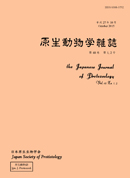
- Issue 1-2 Pages 1-
- |<
- <
- 1
- >
- >|
-
Masaki Ishida, Manabu Hori2017 Volume 50 Issue 1-2 Pages 1-14
Published: November 30, 2017
Released on J-STAGE: December 27, 2017
Advance online publication: April 06, 2017JOURNAL FREE ACCESS FULL-TEXT HTMLBefore aseptic isolation, two Paramecium strains with genome sequences compiled in ParameciumDB were rinsed with sterilized saline solution and were starved for 1 day in the same solution. After starvation, the cells were transferred to Klebsiella-dominant green barley infusion for two days to eliminate unknown bacteria of the bacterized culture to some degree. Then cells were processed using an aseptic isolation method combining two classical isolation methods: “tree” and “handwashing.” They were inoculated into the axenic medium. Asepsis of these cultures was examined using an agar plate test and PCR with universal primer for 16S rRNA gene. The maximum cell density of the axenic culture in both species increased linearly with the times of subculture increase. After adaptation to the axenic medium, the maximum cell density reached a plateau level: 3,000–4,000 cells/ml in P. multimicronucleatum and 14,000–15,000 cells/ml in P. tetraurelia. The generation times at the mid-log phase of growth were calculated as 14.2 and 12.2 h in P. multimicronucleatum and P. tetraurelia, respectively. In this study, egg yolk or the soybean lecithin was tested as a substitute for phosphatidylethanolamine, with fixing of the lipid/stigmasterol ratio at 80 : 1. Results show that the maximum cell density, equivalent to that obtained using phosphatidylethanolamine, was obtained using soybean lecithin. This report includes data demonstrating the percentage of cells in a reproductive stage of every axenic strain using DAPI.
View full abstractDownload PDF (2736K) Full view HTML
-
Fumie Kobayashi, Shin-Ichi Inoue2017 Volume 50 Issue 1-2 Pages 15-28
Published: November 30, 2017
Released on J-STAGE: December 27, 2017
Advance online publication: December 01, 2017JOURNAL FREE ACCESS FULL-TEXT HTMLMalaria remains one of the most serious infectious diseases with the high morbidity and mortality among children in the world. Malaria is caused by protozoan parasites of genus Plasmodium. An efficient vaccine for malaria has not successfully developed for the eradication yet. Thus, to support malaria vaccine development, we have to uncover the mechanisms for protective immunity against Plasmodium infection. We have clarified γδ T cell-related protective immunity against erythrocytic stages of malaria parasites by using low virulent Plasmodium berghei-infected mice. Here we summarize recent advances, including our studies, in understanding mechanisms of immune response to erythrocytic stages of Plasmodium infection.
View full abstractDownload PDF (7101K) Full view HTML
- |<
- <
- 1
- >
- >|